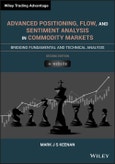The definitive book on Positioning Analysis - a powerful and sophisticated framework to help traders, investors and risk managers better understand commodity markets
Positioning Analysis is a powerful framework to better understand commodity price dynamics, risk, and sentiment. It indicates what each category of trader is doing - what they are trading, how much they are trading and how they might behave under a variety of different circumstances. It is essential in isolating specific types of flow patterns, defining behavioral responses, measuring shifts in sentiment, and developing tools for better risk management. Advanced Positioning, Flow and Sentiment Analysis in Commodity Markets explains the fundamentals of Positioning Analysis and presents new concepts in Commodity Positioning Analytics. This invaluable guide helps readers recognize how certain types of positioning patterns can be used to develop models, indicators, and analyses that can be used to enhance performance.
This updated second edition contains substantial new material, including analytics based on the analysis of flow, the decomposition of trading flows, trading activity in the Chinese commodity markets, and the inclusion of Newsflow into Positioning Analysis. Author: Mark J S Keenan, also covers the structure of positioning data, performance attribution of speculators, sentiment analysis and the identification of price risks and behavioral patterns that can be used to generate trading signals.. This must-have resource:
- Offers intuitive and accessible guidance to commodity market participants and risk managers at various levels and diverse areas of the market
- Provides a wide range of analytics that can be used directly or integrated into a variety of different commodity-related trading, investment, and risk management programs
- Features an online platform comprising a wide range of customizable, regularly-updated analytical tools
- Contains an abundance of exceptional graphics, charts, and illustrations
- Includes easy-to-follow instructions for building analytics.
Advanced Positioning, Flow and Sentiment Analysis in Commodity Markets: Bridging Fundamental and Technical Analysis, 2nd Edition is an indispensable source of information for all types of commodity traders, investors, and speculators, as well as investors in other asset classes who look to the commodity markets for price information.
Table of Contents
About the Author xi
Acknowledgements xiii
Preface xv
About the Companion Website xvii
Introduction 1
Chapter 1 Advanced Positioning, Flow, and Sentiment Analysis in Commodity Markets 7
1.1 Positioning Analysis - What is It? 8
1.2 The History of Positioning Data, the COT Report, and the Agencies that Provide the Data 10
1.3 Misunderstandings and Issues in Positioning Analysis 10
1.4 Futures and Options Data 17
Chapter 2 The Structure of the Positioning Data 19
2.1 The Structure of Positioning Data 20
2.2 Positioning Data for the London Metal Exchange (LME) - The MiFID Classifications 28
2.3 Other Types of Positioning and Flow Data 33
2.4 The Structure of Commodity Markets 34
Chapter 3 Performance Attribution - An Insight into Sentiment and Behavioural Analysis? 45
3.1 The Proliferation of Speculative Positioning Data 46
3.2 Why is Positioning Data Interesting 47
3.3 Measuring the Skill or Performance of MMs 48
3.4 Net Futures Positioning vs Net Trader Number Positioning or Alignment 55
Chapter 4 Concentration, Clustering, and Position Size - Price Risks and Behavioural Patterns 59
4.1 Concentration, Clustering, and Position Size 60
4.2 Concentration, Clustering, Position Size, and Their Relationship to Price Over Time 62
Chapter 5 ‘Dry Powder (DP)’ Analysis - An Alternative Way to Visualise Positioning 71
5.1 Dry Powder (DP) Analysis 72
5.2 DP Indicator Variations 75
5.3 DP Indicators and Trading Signals 82
Chapter 6 Advanced DP Analysis - Deeper Insights and More Variables 87
6.1 Advanced DP Indicator Charts 88
6.2 DP Indicators, Price, and Curve Structure 96
6.3 DP Hedging Indicators 99
6.4 DP Factor, Fundamental, and Currency Indicators 101
Chapter 7 Decomposing Trading Flow and Quantifying Position Dynamics 111
7.1 Decomposing Net Positioning - The Methodology 112
7.2 Decomposing Long and Short Positioning - The Methodology 115
7.3 Who Has Been Driving Prices? 116
7.4 Who is Trading with Whom? 118
7.5 The Impact on Prices 122
7.6 Speed of Positioning Changes 124
Chapter 8 Overbought/Oversold (OBOS) Analysis - The Intersection of Extremes 127
8.1 The Overbought/Oversold (OBOS) Philosophy 128
8.2 Constructing the Framework 128
8.3 The OBOS Concentration Indicator 132
8.4 Key Attributes of the OBOS Approach 133
8.5 Behavioural Patterns within the Boxes 134
8.6 OBOS Variations 138
8.7 The DP/OBOS Hybrid Indicator 141
Chapter 9 Advanced OBOS Analysis - Extremes in Sentiment and Risk 147
9.1 The OBOS Framework - Clustering and Position Sizes 147
9.2 OBOS Factor Indicators 155
9.3 Commodity Risk Premia - Positioning Analysis and Risk Management 159
Chapter 10 Sentiment Analysis - Sentiment Indices and Positioning Mismatches 163
10.1 The Difference between Trader Numbers and Open Interest 164
10.2 Trader Sentiment (TS) Indices 166
10.3 Mismatches in Positioning and Price Inflexion Points 172
Chapter 11 Newsflow in Positioning Analysis 177
11.1 Newsflow Data in Commodity Markets 178
11.2 Building Basic Newsflow Indices 181
11.3 Combining Newsflow with Positioning 186
11.4 Economic Policy Uncertainty 190
Chapter 12 Flow Analysis - The ‘Flow Cube’ and the ‘Build Ratio’ in Commodity Markets 191
12.1 The Flow Cube 192
12.2 The Flow Cube down the Forward Curve 198
12.3 The LBMA-i Trade Data 202
Chapter 13 Chinese Commodity Markets - Analysing Flow 203
13.1 The Chinese Commodity Exchanges 203
13.2 The Size of the Chinese Commodity Exchanges 205
13.3 Speculative vs Hedging Activity in Chinese Commodities 208
13.4 The Flow Cube and Build Ratio in Chinese Commodities 210
13.5 The OBOS Framework and the Speculation Ratio 212
Chapter 14 Machine Learning - A Machine’s Perspective on Positioning 215
14.1 Introduction to Machine Learning (ML) 216
14.2 Decision Trees 217
14.3 Feature Importance 227
14.4 Random Forests 229
14.5 Using ML to Trade 232
Appendix 1 History of the COT Report 235
Appendix 2 The COT Reports 237
Index 249








